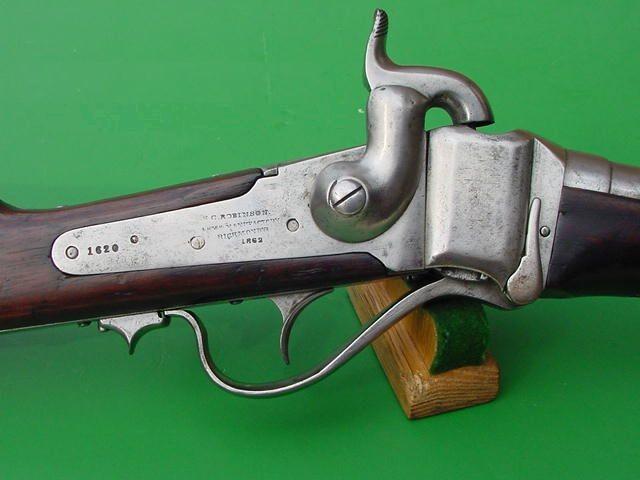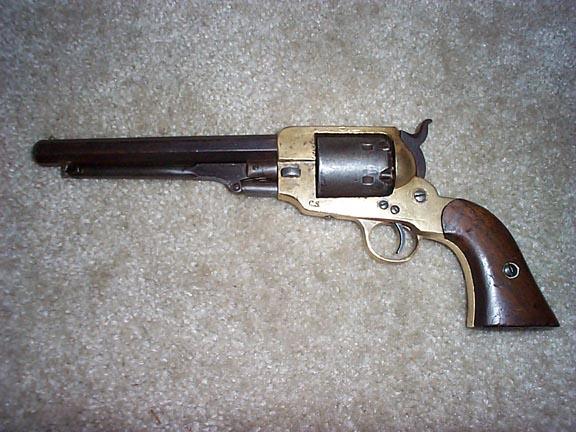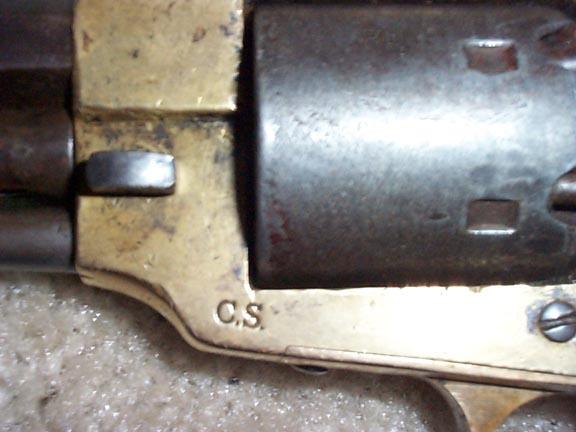THE ROBINSON REVOLVER: Ultra rare original or worthless fake?
An American visitor sent us photographs of a very curious Civil War era percussion revolver and asked us to help him establish its origin, which he thinks to be the Robinson Factory of Richmond. If this origin could be proved, what we have here would be one of the rarest Confederate revolvers still in existence today.
Il will only give my personal opinion, based on the received photographs and my modest knowledge on that field. I am not in a position to confirm or infirm anything and I therefore advised the owner to have his arm examined by specialists.
THE ROBINSON FACTORY
Very few information about that company is available, especially about its status before and at the beginning of the Civil War.
According to very fragmented and not always checkable info, before the war the Robinson Factory produced hunting weapons, cutlery, material and tools for the agriculture and other hardware, as did Remington and Whitney in their early years.
Among Old West arms collectors, the Robinson Factory is better known as a maker of excellent copies of the Model 1859 Sharps falling-block carbine in .52 caliber and called "the Robinson Sharps" (see pictures)


The Robinson was contracted by the Confederate Government for the production of these carbines for the Southern Army. From 1861 to 1863, about 3,500 were made and delivered to the Confederate Ordnance Board. In 1863-64, the Confederate Government took over the Robinson Factory activities, and produced another 1,500 carbines. Supposedly, the march of General Grant's Union Army towards Richmond brought an end to these activities and caused the Factory shops to be dismantled.
Fact is, however, that the Robinson Factory had also another contract with the Confederate Government, signed in 1861, for the manufacture of a number of revolvers (15,000?) of the Whitney Navy -type, in the .36 caliber. The factory did have the necessary machinery and tools for the manufacture of these revolvers, and even the required blueprints.
However, there is no evidence whatsoever of the existence of any of these revolvers in or around 1861, neither in scholar texts, nor in any part of archives.
In November, 1861, Edward Spiller, David Burr and Lt James Burton founded the Spiller&Burr company, whose purpose was the manufacture of 15,000 revolvers of the Colt Navy type to fulfil a new contract signed with the Ordnance Board. S&B purchased the necessary machines and tools from the Robinson Factory, along with the blueprints.
Although this allegation is purely speculative, the decision to abandon the manufacture of Colt copies and to produce Whitney copies instead seems logical, since S&B had the proper machinery and the detailed blueprints on hand for the manufacture of a solid-frame, technically superior revolver. The decision to use brass instead of iron to cast the frames came from Major Downer and was probably based on the lack of iron and steel in the Confederacy.
ROBINSON REVOLVER
In November, 1861, Edward Spiller, David Burr and Lt James Burton founded the Spiller&Burr company, whose purpose was the manufacture of 15,000 revolvers of the Colt Navy type to fulfil a new contract signed with the Confederate Ordnance Board. S&B purchased the necessary machines and tools from the Robinson Factory, along with the blueprints, while the Robinson Factory was to focuse on the production of their very good copy of the Sharps carbine.
Although this allegation is purely speculative, the decision to abandon the manufacture of Colt copies and to produce Whitney copies instead seems logical, since S&B had the proper machinery and the detailed blueprints on hand for the manufacture of a solid-frame, technically superior revolver. The decision to use brass instead of iron to cast the frames came from Major Downer and was probably based on the lack of iron and steel in the Confederacy.
The State of Virginia is also known to have purchased, during the year 1860, an undetermined number of Whitney revolvers on the open market, with a view to arming its militia for the imminent conflict. The year 1860 is to be kept in mind, as well as the VA stamp visible on the left side of the frame, below the cylinder of our visitor's gun.
THE ALLEDGED ROBINSON REVOLVER
The revolver itself shows no special features. At first glance, it seems a standard Whitney Navy 1858, or at least a very close copy of this famous revolver.
Like the Whitney, it has an iron frame.
Top flat of the barrel shows the mention "S.C. ROBINSON, 9th & ARCH STS, RICHMOND VA". On the left side of frame and barrel a letter R is stamped, while a figure 9 appears on the left sides of both the rammer and lug. The initials VA are stamped on the left side of the frame, under the cylinder.
That is about all the information I have. So I decided to compare the photographs sent by our visitor with pictures of a certified authentic Spiller&Burr 2nd Model, and my own Whitney Navy, which is an early 2nd Model 1st Type with a 4-digit serial# , issued in 1859.
Based on the certified and verified historical data, I can immediately certify that our visitor's arm is NOT one of the revolvers purchased by the State of Virginia, and this for the following reasons:
- During the year 1860, the only Whitney the State of VA could purchase on the open market were original, standard Whitney of the newest available model, meaning the 2nd Model 1st type identical to mine, since the later types had not yet been issued. That revolver features a ball-catch to the ramrod and a 7 grooves counterclockwise rifling. The cylinder has only one safety notch on one of the nipple shields.
Besides, those revolvers, numbered from 1 to about 2100, are marked E. WHITNEY - NEW HAVEN in 2 lines on top of the barrel. Serial# are stamped in 4 different locations, being the top flat of the ramrod, the frame under the trigger guard (must be disassembled to see the number), and the inside of each of the wooden grips.
On the pictures provided by our visitor and showing the disassembled grip, one can easily see that no number at all is stamped on the inside of the grips. Besides, his revolver has the Colt type ramrod catch, which was not introduced before 1862-63; and, last but not least, on the picture showing the barrel muzzle one can easily see that the barrel has only 5 grooves. That change occured only on the 6th type, issued in 1864.
For these reasons, our visitor's gun CAN NOT be one of the Whitneys bought by the State of VA in 1860, which tends to proove that the VA stamped on the frame is bogus, which de facto renders all other markings suspect, in particular the Robinson name and address on top of the barrel. Since the State of VA had no contract at all with the Robinson Factory, it had no reason - and no right - to have that address stamped on original Whitneys coming from the open market. Those two markings should never be found on the same gun.
There is a distinct difference between a party of arms purchased on the open market by one of the Confederate States, and a contract signed between the Confederate Government and a maker for the manufacture of a number of new guns..
I was unable to identify the small stamp visible in the middle of the hinge block, as well as the profusion of letters R and figures 9 on the frame. On basis of the above and knowing that the Confederate had more important problems to take care of, than marking their guns, one can start asking oneself questions...
I don't know at all whether the Robinson Factory was located at the corner of 9th and Arch Streets as said in the barrel marking, but a number of elements regarding that address are very uncommon:
- The barrel address reads S.C. ROBINSON followed by a full postal address, while the Robinson Sharps carbines were marked "S.C. ROBINSON, Arms Manufactory, Richmond VA "on both the barrel and lockplate. Those made under Confederate Govt control were simply marked "RICHMOND VA".
Indications of street names do not exist in American barrel addresses, or are at least rarely encountered. A standard barrel address gives only the maker's name, the city or state, and the patent numbers. For instance: "Smith&Wesson, Springfield, Mass", or "Address Col Colt Hartford CT USA" or "Remington & Sons, Ilion NY" etc.
- The barrel marking has evidently been stamped using separate dies that were not well aligned. This is highly bizarre, considering that the Robinson had to manufacture an important number of handguns, and the general use of roller dies for address markings among American armsmakers.
That kind of unprofessional hand marking is even less explicable since we know that the later S&B used the material and tools purchased from the Robinson Factory, and that their addresses were roller-die stamped. Not to mention shape and size of the letters, which I can't verify on basis of the poor info I have on hand.
OTHER SUSPECT DETAILS
- Comparing the photographs of the three arms, I see immediately an important difference in the shape of the cylinder locking notches. The notches on the alledged Robinson revolver are evidently much longer and narrower than those of the Whitney and Spiller&Burr ones. I am absolutely sure that this cylinder could not be used on a Whitney nor on a S&B. This is very curious, since S&B used the Robinson machinery for the manufacture of their revolvers, and that S&B ramrod and cylinders are known to be so close to the Whitney ones, that they can interchange.
This technical detail is very important, because it has a direct influence on the interaction of all parts of the lock mechanism:
- Deeper, longer and narrower notches means also a longer, higher and narrower cam head, and a slightly longer "tail" so that the oblic pin on the hammer can till it up far enough to lower the cam head, in order to allow the cylinder to turn freely.
- Placing the notches closer to the nipple nests also supposes that the gate in the frame under the cylinder was also
moved rearwards and made narrower and longer in order to accomodate the cam head.
-These new position means automatically that the cam head is made shorter ahead of its axis, while the right branch of the bifide return spring has to be made slightly longer.
-Also the length of the hand must be accomodated, in order to ensure a proper alignment of the chambers with the barrel.
Question: why would a maker who has on hand all the necessary tools and blueprints to manufacture a weapon that had already proven its quality since 1858, order its engineers to study and realize unnecessary changes, and this in a stressy period where the Confederation eagered to find as quickly as possible as many weapons as possible ?
Certainly not the fear for claims on any patent infrignment, since all revolvers made by Confederate armsmakers were unlicensed Colt or Whitney copies. Besides, the Confederate Government did not intend at all to show any respect to the federal laws on any subject.
Moreover, why would S&B come back later to the original Whitney configuration ?
Finally, another details has drawn my attention and tends to confirm that this revolver is a fake: on the pictures provided by our visitor showing the disassembled grip, two small circular marks are clearly visible in the metal of the forestrap of the grip frame. This kind of marks never appear on any original antique weapon, for they are traces of injection of melted steel under pressure in a mould, which is a very modern technique. Alhough the technique of melted steel was discovered in about 1885 - 20 years after the Civil War - the method of injecting it under pressure appeared recently.


CONCLUSIONS
With all due respect to Mr Edmunds, Confederate Consultant (passed away a few weeks ago) who is said to have certified the Robinson revolver to be an original, the latter is in my personal modest opinion a worked-over modern replica. I asked our visitor to send me a copy of Mr Edmunds' confirmation and asked on which criteria he based his authentification, since there is no known certified comparable material nor documentation in the world about true Robinson revolvers.
I cannot tell who prodced this replica. It seems like neither Uberti nor Pietta have issued Whitney replicas, but Palmetto did. I have found pictures of the Palmetto one, which is a copy of the latest type, having only 5 grooves and a safety notch on each nipple shield, which does not matches our visitor's gun. This comment doesn't mean a lot, since i don't know how many makers issued replicas of the Whitney.
Our visitor told me he sold the gun recently for $ 95,000...so he made quite a good deal, but I think a fellow collector lost alot of money here....but who am I ?
Marcel